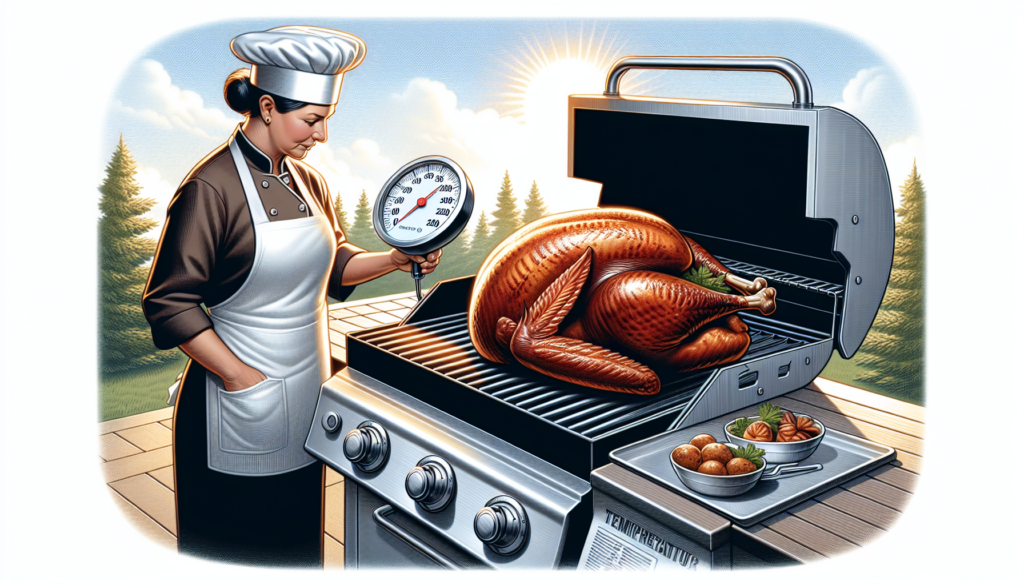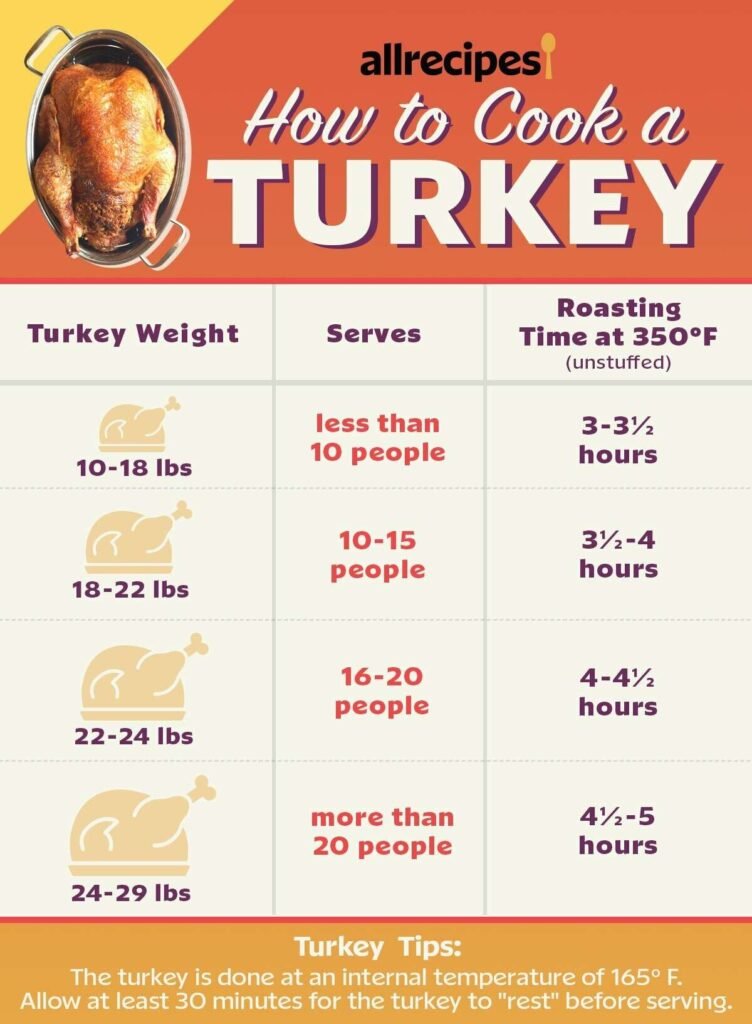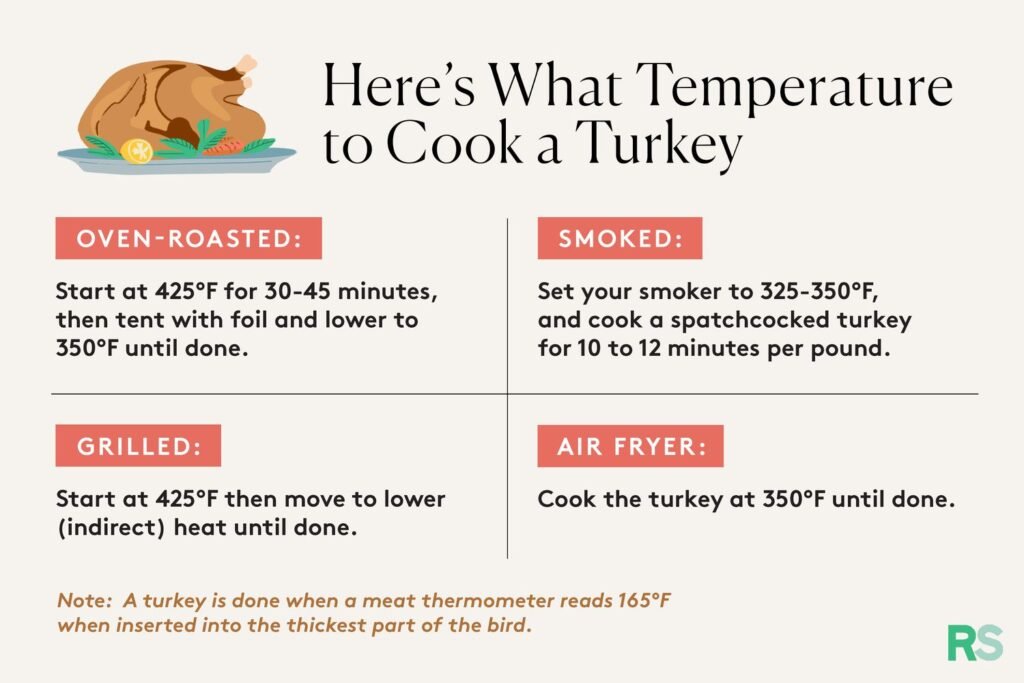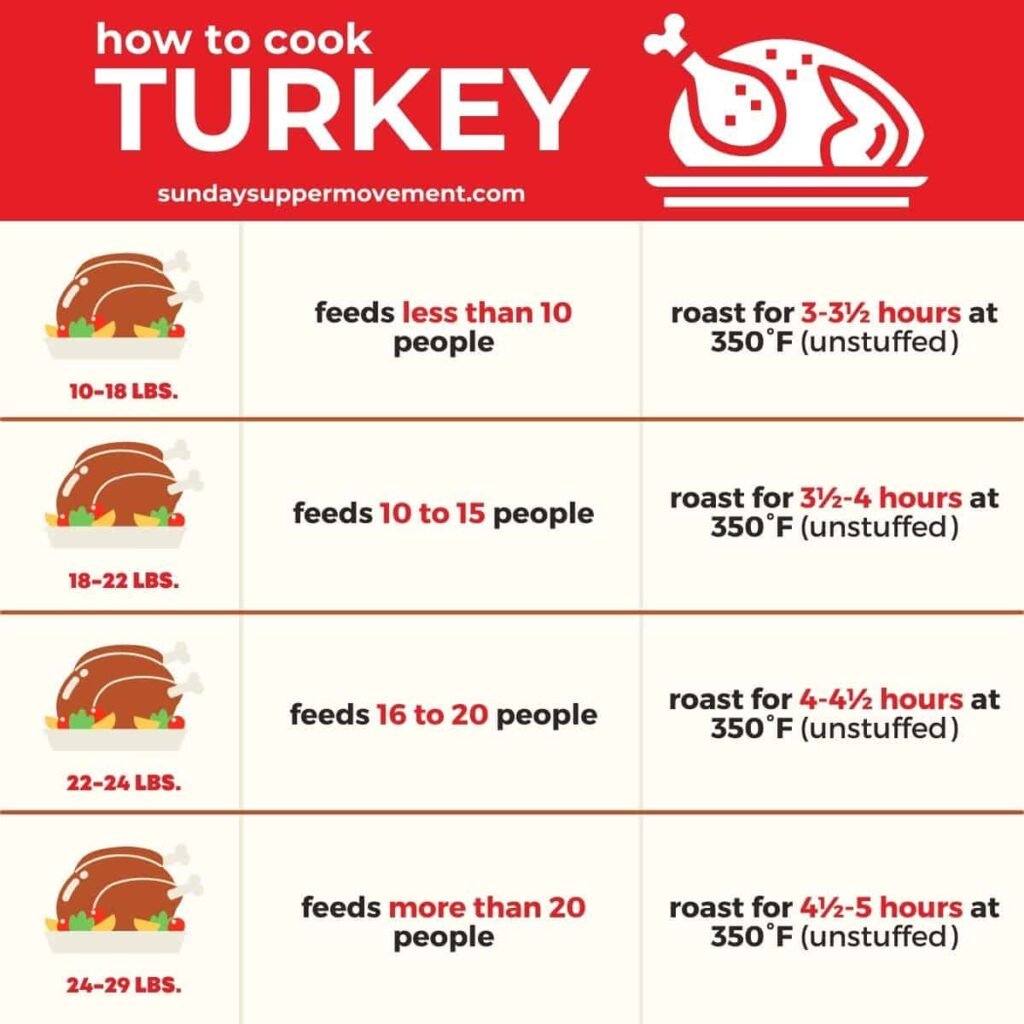Are you looking to kick your Thanksgiving feast up a notch this year? Grilling a turkey might just be the adventurous twist you’re seeking. But before you fire up the grill, it’s crucial to know the perfect temperature for grilling a turkey. Achieving that mouthwatering combination of tender meat and crispy skin requires careful temperature control. In this article, we’ll guide you through the ideal temperature range that will ensure your grilled turkey is a showstopper on your holiday table. Get ready to impress your guests with a turkey like they’ve never tasted before!

Preparing the Turkey
Preparing the turkey is the first step toward a successful and delicious grilled turkey. Two important aspects of preparing the turkey are thawing it properly and seasoning it to enhance the flavors.
Thawing the Turkey
Thawing the turkey is crucial to ensure even cooking and prevent the growth of harmful bacteria. The recommended method for thawing a turkey is to place it in the refrigerator, allowing about 24 hours of thawing time for every 4-5 pounds of turkey.
To thaw the turkey, remove the packaging and place it on a tray or dish to catch any drips. It is important to keep the turkey separated from other food items in the refrigerator to avoid cross-contamination. Thawing the turkey in the refrigerator not only ensures safe thawing but also helps retain the moisture within the meat.
Seasoning the Turkey
Seasoning the turkey is an essential step to enhance the flavors and add a delicious aroma to your grilled turkey. Before applying the seasoning, make sure to pat the turkey dry with paper towels to ensure the seasoning adheres properly.
There are numerous seasoning options to choose from, ranging from traditional turkey rubs to marinades and brines. A classic turkey rub typically consists of a combination of herbs, spices, salt, and pepper. Alternatively, you can marinate the turkey in your favorite mixture of herbs, spices, oil, and acidic ingredients like lemon juice or vinegar. Brining is another popular technique where the turkey is soaked in a saltwater solution overnight, resulting in a moist and flavorful bird.
Experiment with different seasoning options to find a flavor profile that suits your taste preferences. Remember to pay attention to the salt content in your seasoning to avoid overly salty meat. Once the turkey is seasoned, let it sit at room temperature for about 30 minutes to allow the flavors to penetrate the meat before grilling.
Choosing the Right Temperature
Choosing the right temperature is crucial to achieving a perfectly grilled turkey. Factors such as the turkey’s weight, the grill’s heat output, and the desired level of doneness should be taken into consideration.
Factors to Consider
Several factors need to be considered when choosing the right temperature for grilling a turkey. The weight of the turkey plays a significant role in determining the cooking time and temperature. Larger turkeys typically require lower temperatures and longer cooking times to ensure thorough cooking without burning the skin.
The heat output of your grill is another important factor to consider. Gas grills generally allow for more precise temperature control compared to charcoal grills. Charcoal grills require more attention to maintain a consistent temperature throughout the grilling process. Additionally, the type and thickness of the grill grate can affect the heat distribution, so it’s important to choose the right grate for optimal cooking results.
Lastly, the desired level of doneness should be considered when choosing the temperature. A higher internal temperature will result in a well-cooked turkey, but be careful not to overcook it, as it can result in dry meat. On the other hand, a lower internal temperature will yield a juicier but potentially undercooked bird.
Recommended Grill Temperatures
For most grilled turkeys, a grill temperature of 325°F (163°C) is recommended. This temperature allows for even cooking without excessive charring of the skin. It is important to preheat the grill to the desired temperature before placing the turkey on the grate.
If you prefer a slightly crispier skin, you can start with a higher temperature of around 375°F (190°C) for the first 30 minutes and then reduce the temperature to 325°F (163°C) for the remainder of the cooking time. Adjust the grill temperature accordingly based on the factors mentioned earlier and the specific instructions for your grill model.
Using a Meat Thermometer
Using a meat thermometer is essential to ensure that your grilled turkey is cooked to the proper internal temperature, guaranteeing both safety and optimal taste.
Importance of a Meat Thermometer
A meat thermometer is a small investment that can make a significant difference in the quality of your grilled turkey. It provides an accurate reading of the internal temperature, eliminating the guesswork and ensuring that the turkey is cooked to the desired level. This is particularly important for poultry, as undercooked poultry can pose health risks.
By using a meat thermometer, you can avoid overcooking the turkey, which can result in dry meat. Instead, you can achieve the perfect balance between juiciness and doneness by monitoring the internal temperature throughout the grilling process.
Proper Placement of the Thermometer
To get an accurate reading, it is crucial to place the meat thermometer correctly in the turkey. The thermometer should be inserted into the thickest part of the thigh, without touching the bone. The thigh is the slowest part to cook, so measuring the internal temperature of the thigh ensures that the turkey is fully cooked.
When inserting the thermometer, make sure it is not touching any bone as this can affect the accuracy of the reading. Be cautious not to puncture through to the other side of the turkey, as this can cause the juices to escape and result in drier meat. Place the thermometer near the center of the thigh, but not too close to the joint, for the most accurate reading.
Grilling Techniques
Grilling a turkey involves utilizing different techniques to cook the meat evenly and achieve the desired level of char and smoky flavor.
Direct Grilling
Direct grilling involves cooking the turkey directly over the heat source, typically with the grill lid open. This technique is suitable for smaller turkeys or turkey parts that cook relatively quickly. It allows for a quicker cooking time and provides a slightly charred exterior.
To direct grill a turkey, preheat the grill to the recommended temperature and place the turkey directly over the heat source. Flip the turkey occasionally to ensure even cooking and prevent excessive charring. Keep a close eye on the internal temperature using a meat thermometer to prevent overcooking.
Direct grilling is best suited for turkeys up to 12 pounds. For larger turkeys, it is recommended to use the indirect grilling technique for more even and thorough cooking.
Indirect Grilling
Indirect grilling involves cooking the turkey away from the direct heat source, with the grill lid closed. This technique is recommended for larger turkeys or when you want a slower cooking process that allows the flavors to develop more gradually.
To indirect grill a turkey, preheat the grill to the recommended temperature and set up a two-zone fire. This means placing the turkey on the side of the grill with no direct heat underneath, while the burners or charcoal are lit on the other side.
Place a drip pan filled with water or another liquid under the turkey to catch the drippings and prevent flare-ups. The liquid in the drip pan will also add moisture and create steam, enhancing the tenderness of the turkey.
Close the grill lid and maintain the temperature throughout the cooking process, periodically checking the internal temperature using a meat thermometer. This method ensures that the turkey cooks evenly and retains its natural juices for a moist and flavorful result.

Monitoring and Adjusting the Temperature
Monitoring and adjusting the temperature during the grilling process is crucial to maintain an optimal cooking environment and achieve the desired results.
Using Grill Controls
Gas grills typically have control knobs or dials that allow you to adjust the heat output. To maintain the recommended grill temperature, use these controls to increase or decrease the flame intensity. Adjusting the controls closer to the desired temperature will either raise or lower the grill’s heat output accordingly.
Charcoal grills require a bit more attention to maintain a consistent temperature. To raise the temperature, add more lit charcoal to the fire. To lower the temperature, partially close the vents to restrict air flow and reduce the oxygen supply to the coals, which will slow down combustion and lower the heat output.
Regularly monitor the grill thermometer to ensure that the temperature remains within the recommended range. You may need to make slight adjustments throughout the cooking process to compensate for any temperature fluctuations.
Adding Fuel or Adjusting Vents
For longer cooking times, you may need to add more fuel to your grill to maintain a steady temperature. When using a gas grill, keep a spare propane tank nearby to switch out if needed. For charcoal grills, have extra charcoal ready to add to the fire.
When adding fuel, be mindful of any flare-ups that may occur. To avoid excessive charring or burning, use long-handled tongs to add charcoal or adjust the placement of the turkey.
If you notice that the temperature is consistently too high, you can partially close the vents on your grill to reduce the airflow and lower the heat output. Adjust the vents gradually to avoid drastic temperature changes, which may lengthen the cooking time.
Grilling Time
Grilling time varies depending on various factors such as the size of the turkey, the grill temperature, and the grilling technique used. Calculating the cooking time and monitoring the internal temperature will help ensure that your turkey is cooked to perfection.
Calculating Cooking Time
As a general rule of thumb, calculate the cooking time based on the weight of the turkey. Plan for about 13-15 minutes of grilling time per pound of turkey at a grill temperature of 325°F (163°C). This estimation applies to whole turkeys, including bone-in and boneless, skin-on turkey breasts.
However, it is important to note that these times are approximate and should serve as a starting point. It is always recommended to use a meat thermometer to determine the turkey’s doneness, as the internal temperature is a more accurate indicator than the cooking time alone.
Monitoring Internal Temperature
Throughout the grilling process, monitor the internal temperature of the turkey using a meat thermometer. The target internal temperature for a fully cooked turkey is 165°F (74°C) in the thickest part of the thigh.
To prevent overcooking, start checking the turkey’s temperature about 30 minutes before the estimated cooking time is complete. Insert the meat thermometer into the thigh, making sure it does not touch the bone. Once the thermometer reads 165°F (74°C), remove the turkey from the grill and let it rest before serving.

Paying Attention to Safety
When preparing and grilling a turkey, it is essential to prioritize safety to prevent the risk of foodborne illnesses and ensure a pleasant grilling experience.
Handling Raw Turkey
Proper handling of raw turkey is critical to avoid cross-contamination and the spread of bacteria. Always wash your hands thoroughly with soap and water before and after handling raw turkey. Use separate cutting boards, utensils, and plates for raw and cooked foods to avoid any potential bacterial transfer.
When thawing the turkey, place it on a tray or dish to catch any drips and prevent the spread of bacteria. Don’t leave the turkey at room temperature for an extended period, as this can promote bacterial growth. Follow the recommended thawing method to ensure safe and hygienic thawing.
Keeping a Clean Grill
Maintaining a clean grill is essential not only for food safety but also for optimal grilling results. Before grilling the turkey, clean the grill grates thoroughly to remove any buildup of grease, food particles, or debris. This ensures that the turkey cooks evenly and the flavors are not affected by any residue.
After grilling, allow the grill to cool slightly and then clean the grates again to remove any remaining food or grease. Regularly clean the grill grates, drip tray, and any other removable parts according to the manufacturer’s instructions to prevent any potential bacterial contamination.
Alternative Cooking Methods
While grilling is a fantastic way to cook a turkey, there are alternative cooking methods that can add unique flavors and textures to your bird.
Smoking the Turkey
Smoking a turkey infuses it with a rich, smoky flavor and results in tender meat with an appealing outer crust. This method involves slow cooking the turkey over indirect heat using wood chips for a flavorful smoke.
To smoke a turkey, preheat the grill to a low temperature, around 225°F (107°C), and set it up for indirect grilling. Soak wood chips in water or your preferred liquid for at least 30 minutes before adding them to the fire. Place the turkey on the grill away from the heat source, and add the wood chips to create smoke.
Regularly check the internal temperature using a meat thermometer and maintain the grill temperature by adjusting the air vents and adding more soaked wood chips as needed. Smoking a turkey requires a longer cooking time than traditional grilling, so be prepared for a slow and gradual process.
Rotisserie Cooking
Rotisserie cooking offers a unique and flavorful way to grill a turkey. It involves mounting the turkey on a rotisserie spit and slowly turning it over the heat source, resulting in even browning and succulent meat.
To rotisserie cook a turkey, ensure that your grill comes with a rotisserie attachment or purchase one separately. Prepare the turkey by trussing it securely and placing it onto the rotisserie spit. Secure the turkey tightly to prevent any movement during the cooking process.
Preheat the grill to the recommended temperature, usually around 325°F (163°C) for a turkey. Attach the rotisserie spit to the grill and turn on the rotisserie motor. Close the grill lid and let the turkey cook slowly, periodically checking the internal temperature until it reaches 165°F (74°C) in the thickest part of the thigh.

Resting and Serving the Turkey
Resting the grilled turkey before serving is an essential step to allow the juices to redistribute and the flavors to develop further.
Resting Time
To ensure a juicy and flavorful turkey, let it rest for about 20-30 minutes before carving. Remove the turkey from the grill and transfer it to a cutting board. Loosely tent the turkey with aluminum foil to keep it warm and allow it to rest undisturbed.
During the resting period, the internal temperature of the turkey will continue to rise slightly, and the juices will redistribute, resulting in tender and moist meat. The resting time also allows for easier carving, as the meat will be more relaxed and less likely to tear.
Serving Suggestions
Once the turkey has rested, it is ready to be carved and served. How you serve the turkey is entirely up to you and your personal preferences. Consider presenting the turkey on a platter with garnishes like herbs, citrus slices, or seasonal fruits for an appealing presentation.
To complement the flavors of the grilled turkey, consider serving it with traditional Thanksgiving sides such as mashed potatoes, roasted vegetables, cranberry sauce, and gravy. Don’t forget to have extra servings of the delicious turkey seasoning or sauce on the side for those who want to enhance the flavor further.
Remember to adjust the portion sizes and accompaniments based on the number of guests and their dietary preferences. Enjoy the fruits of your labor and savor the satisfaction of a perfectly grilled turkey!
Troubleshooting Common Issues
Despite our best efforts, sometimes issues may arise during the grilling process. Here are a few common problems and their potential solutions.
Uneven Cooking
If you encounter uneven cooking where certain parts of the turkey are cooked while others are undercooked, there are a few potential solutions. One option is to rotate the turkey periodically during the grilling process to ensure even exposure to the heat. Another option is to use a two-zone fire setup for indirect grilling, allowing the turkey to cook more evenly.
Additionally, you can use aluminum foil to cover the areas that are cooking too quickly. This will help prevent excessive charring while allowing the slower-cooking parts to catch up. Regularly check the internal temperature and make adjustments to the grill temperature or cooking time as needed until the entire turkey is cooked to perfection.
Dry Turkey
If you end up with a dry turkey, it may be due to overcooking or insufficient moisture during the grilling process. To prevent dryness, ensure that your grill temperature is not too high, as excessive heat can cause the meat to dry out. Monitor the internal temperature regularly and remove the turkey from the grill as soon as it reaches 165°F (74°C) to avoid overcooking.
Consider using a basting brush to apply a basting liquid throughout the grilling process. This can help add moisture and flavor to the turkey, preventing it from drying out. You can use a mixture of melted butter, herbs, broth, or even the turkey juices to baste the turkey periodically.
If the turkey still ends up dry despite these efforts, consider serving it with a delicious gravy or sauces to add extra moisture and flavor. Also, remember to allow the turkey to rest after grilling, as this will help the juices redistribute and further enhance the meat’s tenderness.
Grilling a turkey can be a rewarding and enjoyable experience. By following these tips and techniques, you’ll be well-equipped to prepare a mouthwatering grilled turkey that impresses your family and guests. Remember to experiment, have fun, and savor the delicious results of your grilling adventure!

